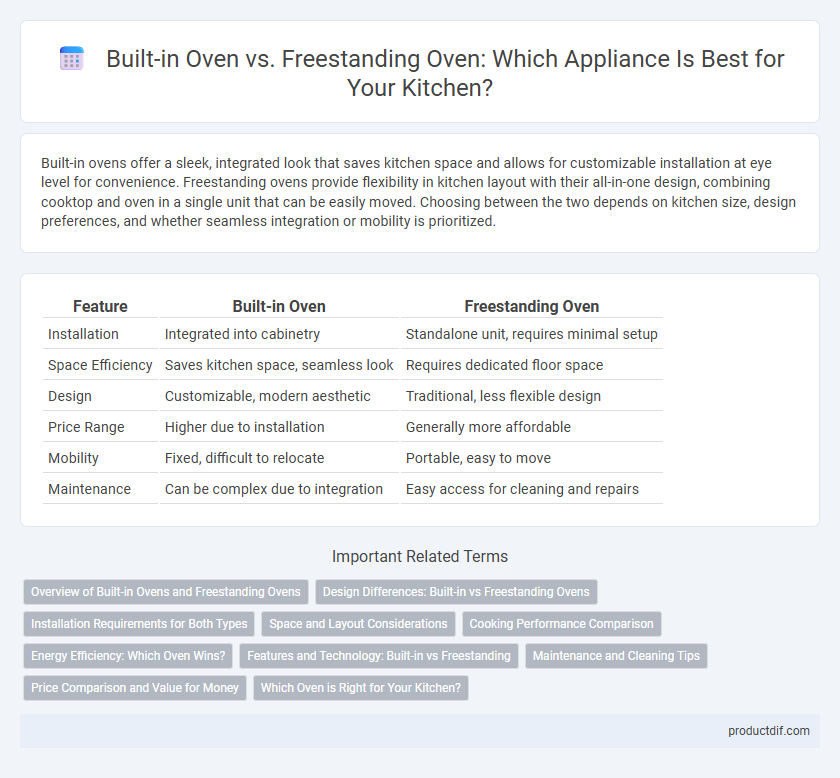Built-in ovens offer a sleek, integrated look that saves kitchen space and allows for customizable installation at eye level for convenience. Freestanding ovens provide flexibility in kitchen layout with their all-in-one design, combining cooktop and oven in a single unit that can be easily moved. Choosing between the two depends on kitchen size, design preferences, and whether seamless integration or mobility is prioritized.
Table of Comparison
| Feature | Built-in Oven | Freestanding Oven |
|---|---|---|
| Installation | Integrated into cabinetry | Standalone unit, requires minimal setup |
| Space Efficiency | Saves kitchen space, seamless look | Requires dedicated floor space |
| Design | Customizable, modern aesthetic | Traditional, less flexible design |
| Price Range | Higher due to installation | Generally more affordable |
| Mobility | Fixed, difficult to relocate | Portable, easy to move |
| Maintenance | Can be complex due to integration | Easy access for cleaning and repairs |
Overview of Built-in Ovens and Freestanding Ovens
Built-in ovens are integrated into kitchen cabinetry, offering a seamless and space-saving design that enhances kitchen aesthetics and provides customizable installation heights. Freestanding ovens combine both the oven and cooktop in a single appliance, allowing easy placement anywhere in the kitchen with simpler installation and often including storage compartments below. Both types vary in dimensions, features, and ventilation requirements, catering to different kitchen layouts and cooking preferences.
Design Differences: Built-in vs Freestanding Ovens
Built-in ovens feature a sleek, integrated design that fits flush within cabinetry, maximizing kitchen space and creating a seamless, modern aesthetic. Freestanding ovens offer flexibility with their standalone design, including attached cooktops and visible sides, allowing easier relocation and installation. The choice between built-in and freestanding ovens significantly impacts kitchen layout, style cohesion, and space utilization.
Installation Requirements for Both Types
Built-in ovens require precise measurements and professional installation within kitchen cabinetry, ensuring seamless integration and optimal use of space. Freestanding ovens only need level flooring and access to existing electrical or gas connections, providing flexibility in kitchen placement without major modifications. Proper ventilation and adherence to manufacturer guidelines are essential for both types to ensure safety and performance.
Space and Layout Considerations
Built-in ovens save valuable kitchen space by integrating seamlessly into cabinetry, allowing for a more streamlined and customized layout. Freestanding ovens offer greater flexibility in placement but require dedicated floor space and may disrupt the flow of a compact kitchen design. Choosing between the two depends on kitchen size, existing cabinetry, and the desired aesthetic for optimal functionality.
Cooking Performance Comparison
Built-in ovens offer precise temperature control and even heat distribution, enhancing cooking consistency and making them ideal for baking and roasting. Freestanding ovens typically provide greater capacity and flexibility, accommodating a variety of meal types and larger cookware. The choice between built-in and freestanding ovens ultimately impacts cooking performance based on kitchen layout, cooking frequency, and meal complexity.
Energy Efficiency: Which Oven Wins?
Built-in ovens generally offer better energy efficiency due to their integration into kitchen cabinetry, which reduces heat loss and improves insulation compared to freestanding ovens. Freestanding ovens, while versatile and easier to install, often have less effective insulation, leading to higher energy consumption during cooking cycles. Energy Star-rated built-in models can further enhance savings by using advanced technology to optimize heat distribution and minimize power usage.
Features and Technology: Built-in vs Freestanding
Built-in ovens integrate seamlessly into cabinetry, offering a streamlined look and space-saving design with advanced features like touch controls, convection cooking, and smart connectivity. Freestanding ovens provide versatility and mobility, typically combining a cooktop and oven with traditional knobs and a range of sizes to fit various kitchen layouts. Both types incorporate technologies such as self-cleaning functions, temperature precision, and energy efficiency, but built-in models often lead in smart appliance innovation and customizable installation.
Maintenance and Cleaning Tips
Built-in ovens require careful sealing checks to prevent food residue buildup, while freestanding ovens benefit from easier access for thorough cleaning behind and beneath the unit. Using a self-cleaning feature or a non-abrasive oven cleaner helps maintain the interior regardless of the oven type. Regularly wiping down control panels and door seals ensures optimal functionality and prolongs the appliance's lifespan.
Price Comparison and Value for Money
Built-in ovens generally have a higher upfront cost compared to freestanding ovens due to custom installation requirements and sleek integration with kitchen cabinetry. Freestanding ovens offer more budget-friendly options and flexibility, making them attractive for cost-conscious buyers seeking straightforward installation. While built-in ovens enhance kitchen aesthetics and may increase property value, freestanding ovens provide better value for money when prioritizing initial investment and ease of replacement.
Which Oven is Right for Your Kitchen?
Choosing between a built-in oven and a freestanding oven depends on kitchen layout, space availability, and aesthetic preferences. Built-in ovens offer a sleek, integrated look and save floor space, making them ideal for modern kitchens with customized cabinetry. Freestanding ovens provide flexibility in placement and are easier to install or replace, perfect for kitchens requiring versatile appliance options.
Built-in Oven vs Freestanding Oven Infographic

 productdif.com
productdif.com